

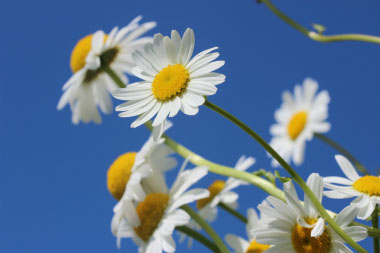

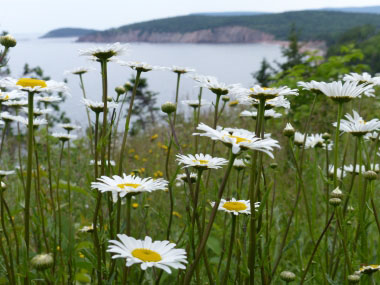
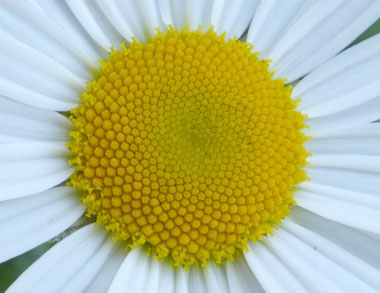
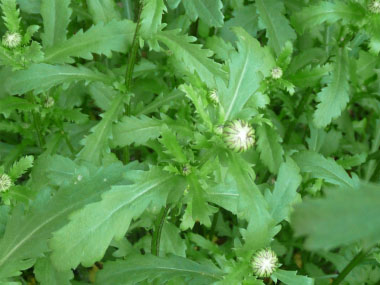

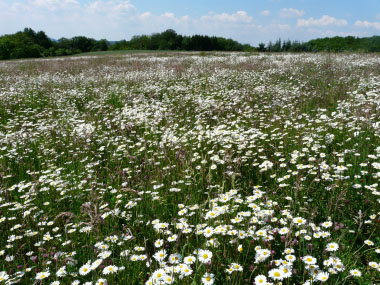
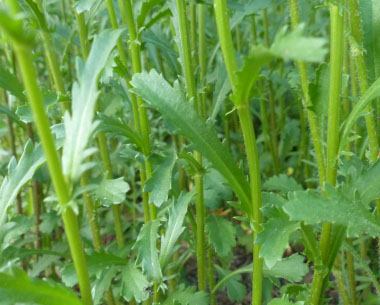
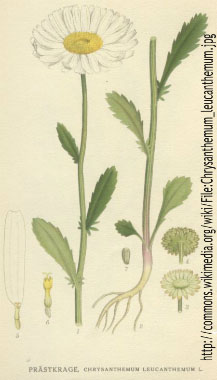
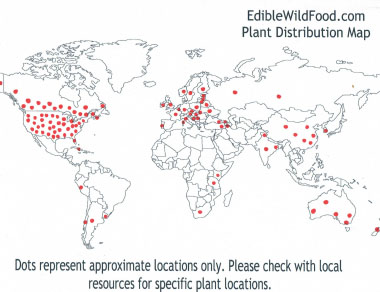
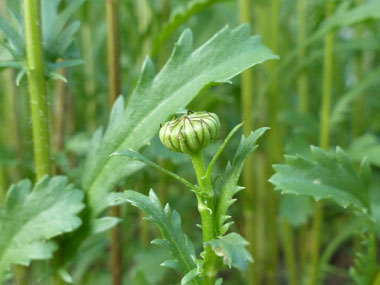
To support our efforts please browse our store (books with health benefits, etc.).
The oxeye daisy is a perennial plant in the Compositae family that looks like several flowers in the aster family. It is often confused with the ornamental shasta daisy (edible) which is a taller plant with larger flowers and a toothed whole leaf. The oxeye daisy leaf is quite different from the shasta with deep lobes. There are many white daisies that have been introduced from Eurasia as ornamental and herbal plants; however, the oxeye daisy has larger flower heads.
Distinguishing Features
In general, daisies are characterized by a long, smooth, central stem that terminates in a single flower head. The star-shaped flower head has a center composed of yellow disc florets surrounded by ray florets with long, white petals. This is perhaps one of the most recognizable flowers in many countries.
Flowers
The daisy has a single flower measuring approximately 2.5 to 6.5 cm (1 to 2.6 “) across, surrounded by involucral bracts. It has white ray-florets. The center disc florets are yellow, tubular, and very small. The oxeye daisy has 5 stamens and a pistil of 2 fused carpels. These flowers bloom anywhere from May to September depending on location.
 Fields
of Nutrition has medicinal benefits and vitamin/mineral content of Oxeye Daisy.
Fields
of Nutrition has medicinal benefits and vitamin/mineral content of Oxeye Daisy.
Leaves
The basal and lower leaves are often oblanceolate with slender petioles, while the middle to upper leaves are more oblong and usually clasp the stem. Leaf margins are coarsely dentate, and some of the alternate leaves are often pinnatifid toward the base. The upper and lower surface of each leaf is pretty much hairless.
Height
This daisy grows between 30 and 90 centimetres tall (1-3’). The stem is virtually hairless.
Habitat
The ox-eye daisy prefers the low fertility of old fields and pastures yet flourishes as a weed in many locations such as meadows, people’s lawns and vacant lots. It tends to prefer well-drained soil and does not like shaded areas. It thrives in direct sunlight and can tolerate high winds. Where the soil has a lime deficiency, oxeye daisies will grow to help replenish the lime. It is native to Europe and parts of Asia (including India and the Far East) and was introduced to North America, Australia and New Zealand. It also grows in South America and in several African nations such as Zimbabwe, Tanzania, Kenya and South Africa.
Edible Parts
The leaves can be eaten raw or cooked. Young spring shoots are finely chopped and added to salads and to soups. Some people find this plant to be somewhat pungent and prefer it cooked. The root can be consumed raw and the flowers can be tossed into a salad or pickled. Young plants are more desirable.
Other Name
Moon Daisy.
Similar Plants
Shasta Daisy, Common Daisy.
Winter Survival Food Handbook

PDF Plant Magazines
Types of Wild Food
Geographic Zones Seasons
Disclaimer
EdibleWildFood.com is informational in nature. While we strive to be 100% accurate, it is solely up to the reader to ensure proper plant identification. Some wild plants are poisonous or can have serious adverse health effects.
We are not health professionals, medical doctors, nor are we nutritionists. It is up to the reader to verify nutritional information and health benefits with qualified professionals for all edible plants listed in this web site. Please click here for more information.
Why Edible Wild Food?
- Food costs are rising
- Free, wild food is readily abundant
- Wild food adds nutrition to your diet
- Wild food can help treat various medical conditions





